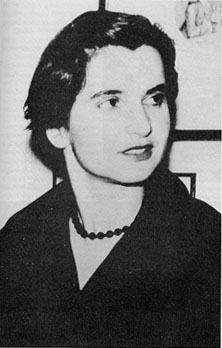
Rosalind Franklin
(1920 - 1958)
Rosalind Franklin was born in London on July 25, 1920. She attended St. Paul's Girls' School. When she was growing up, her parents took in two Jewish children from Nazi Germany to live in their home as part of the family. Rosalind shared her room with a woman whose father had been sent to Buchenwald.
Franklin was strongly influenced by her grandfather, Arthur, who was active in social service and was so committed to Judaism that his will stipulated that only those descendants married to Jews would inherit any of his estate. Franklin’s great-uncle, Herbert Samuel, was the first High Commissioner of Palestine.
Franklin studied chemistry and physics at Newnham College, Cambridge, and, in 1942, began carrying out research at the British Coal Utilization Research Association. Over the next four years she helped develop carbon fibre technology.
In 1947, Franklin went to the Central Government Laboratory for Chemistry in Paris where she worked on X-ray diffraction. In 1951, she moved to King's College, London.
As a woman and a Jew, Franklin felt unwelcome at King's College (the women scientists were not allowed to eat lunch in the common room where the men did). The combination of anti-Semitism and sexism also was an underlying factor in some criticism of her work. In James Watson's book, The Double Helix, Franklin is described as a difficult woman who was unwilling to share her research. She's characterized as a complainer and her appearance and clothes are criticized.
Franlin worked on a DNA project that she thought was her own. When the laboratory's second-in-command, Maurice Wilkins, retruned from a vacation, however, she learned that he expected her to be his assistant rather than a colleague working as an equal. They had an uneasy relationship, complicated by the fact she was a woman in a "man's world" and their conflicting personalities.
Franklin made a number of advances in x-ray diffraction techniques with DNA that allowed her to discover crucial elements in what had become a race between competing research teams to discover the structure of DNA. Franklin produced X-ray diffraction pictures of DNA which were published in Nature in April 1953. This played an important role in establishing the structure of DNA. In fact, many scientists believe Franklin played a larger role than previously acknowledged in the research that led to the 1962 Nobel Prize that was awarded to Maruice Wilkins, Francis Crick, and James Watson for the discovery of DNA's double helix.
Wilkins shared Franklin's data, without her knowledge, with Watson and Crick, at Cambridge University, and they pulled ahead in the race, ultimately publishing the proposed structure of DNA in March 1953.
The difficulty in working with Wilkins and the discomfort of the environment at King's College led Franklin to leave, but the College insisted that she cease work on DNA. Franklin joined John Bernal at Birkbeck College to carry out research into the tobacco mosaic virus. Her group's findings laid the foundation for structural virology.
While visiting the United States, Franklin began to experience terrible pains that she soon learned were related to ovarian cancer. She continued working up until a few weeks before her death on April 16, 1958, at age 37.
Courtesy of:
http://www.jewishvirtuallibrary.org/jsource/biography/franklin.html
